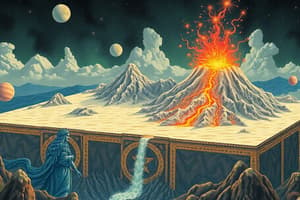Podcast
Questions and Answers
Which type of plate movement can lead to the formation of folds and faults?
Which type of plate movement can lead to the formation of folds and faults?
- Convergent plate movement (correct)
- Transform plate movement
- Subduction plate movement
- Divergent plate movement
What geological features are formed as a result of plate movement?
What geological features are formed as a result of plate movement?
- Deserts
- Rivers
- Caves
- Mountains (correct)
Which process is responsible for the movement of tectonic plates?
Which process is responsible for the movement of tectonic plates?
- Erosion
- Volcanism
- Weathering
- Plate tectonics (correct)
Which type of plate boundary is most likely to result in the formation of folds and faults?
Which type of plate boundary is most likely to result in the formation of folds and faults?
What is the primary cause of plate movement?
What is the primary cause of plate movement?
Which of the following is NOT a type of fold or fault?
Which of the following is NOT a type of fold or fault?
Flashcards are hidden until you start studying
Study Notes
Plate Movement and Geological Features
- Convergent plate movement can lead to the formation of folds and faults due to compressive forces.
- Geological features formed as a result of plate movement include mountains, valleys, earthquakes, and volcanic activity.
Tectonic Plate Movement
- The movement of tectonic plates is driven primarily by convection currents within the Earth's mantle.
- The movement of these plates is also influenced by gravity and the Earth's rotation.
Plate Boundaries and Deformation
- Convergent boundaries are most likely to result in the formation of folds and faults as plates collide and push against each other.
- Divergent boundaries typically result in rift valleys and mid-ocean ridges, while transform boundaries are associated with lateral sliding motions, leading to earthquakes.
Causes of Plate Movement
- The primary cause of plate movement is the heat generated within the Earth's interior, leading to convection currents.
Types of Folds and Faults
- Types of folds include anticlines and synclines, while types of faults include normal, reverse, and strike-slip faults.
- Features like transforms, which indicate lateral movement, are considered types of boundaries, not folds or faults.
Studying That Suits You
Use AI to generate personalized quizzes and flashcards to suit your learning preferences.




